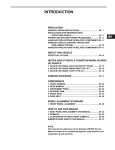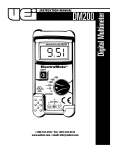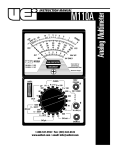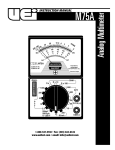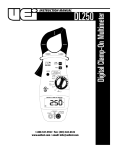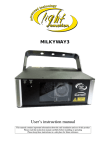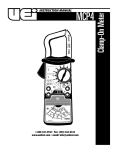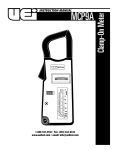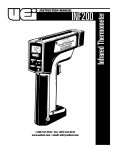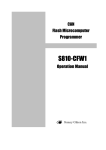Download DL99B Manual - Phoenix Flow Centers
Transcript
DL99B 1-800-547-5740 • Fax: (503) 643-6322 www.ueitest.com • email: [email protected] True RMS Clamp-On Meter INSTRUCTION MANUAL Introduction The D99B Digital Clamp-On Meter is designed for professional electrician's, plant maintenance specialists and service technicians. Now technicians can work with added confidence, knowing they’re measuring with the superior accuracy of True RMS, increasing safety by illuminating dark work areas with a bright LCD Work Light, back light display and extending their measurement capabilities to 1000V AC/DC. Features include • True RMS • Work light and backlit display • 1000 Amps AC and DC • 1000 Volts AC and DC • Resistance to 40 kilohms • Continuity • Push-button ranging • Peak hold • Data hold • 0.1 mV DC resolution allows use of DMM adapters • 1-3/8” jaw capacity • CE and UL listed CAT III • If any of the following indications occur during testing, turn off the power source to the circuit under test: • Arcing • Flame • Smoke • Extreme Heat • Smell of Burning Materials • Discoloration or Melting of Components • Read the safety precautions associated with the equipment being tested and seek assistance or advice when performing unfamiliar tasks. • Keep your fingers away from the test lead metal probe contacts and bus-bars when making measurements. Always grip the instrument and test-leads behind the hand guards (molded into the probes). • In the event of electrical shock, ALWAYS bring the victim to the emergency room for evaluation, regardless of the victim’s apparent recovery. Electrical shock can cause an unstable heart rhythm that may need medical attention. International Symbols Safety Notes Before using this meter, read all safety information carefully. In this manual the word "WARNING" is used to indicate conditions or actions that may pose physical hazards to the user. The word "CAUTION" is used to indicate conditions or actions that may damage this instrument. WARNING! Exceeding the specified limits of this meter is dangerous and can expose the user to serious or possibly fatal injury. • DO NOT attempt to measure any voltage that exceeds 1000 volts DC or AC-RMS with this meter - UEi offers numerous alternatives for measuring high voltage and current • Voltages above 60 volts DC or 25 volts AC may constitute a serious shock hazard • DO NOT attempt to use this meter if either the meter or the test leads have been damaged. Send unit in for repair by a qualified repair facility • Test leads must be fully inserted prior to taking measurements • Always turn off power to a circuit (or assembly) under test before cutting, unsoldering or breaking the current path. Even small amounts of current can be dangerous • Always disconnect the live test lead before disconnecting the common test lead from a circuit • When measuring high voltage, disconnect the power source before making test lead connections. Connect the test leads to the meter first then to the circuit under test. Reapply power DL99B-MAN Listings This instrument is designed and tested in accordance with: IEC Publication 1010-1 (Overvoltage category III), the safety requirements for hand-held current clamps for electrical measurements and tests, the EMC directive, and other safety standards. P. 1 6. Peak Hold Push-Button: Used to capture the highest AC or DC inductive amp reading. Controls and Indicators 2 7. Clamp Lever: Opens and closes current clamp jaw. 1 8. DC A Zero: Used to establish the “zero reference” when preparing to make DC amperage measurements. Magnetic fields in the iron core of the jaws will be interpreted as a current reading if not electronically compensated when measuring DC amps. 9. Rotary Function Switch: Used to power the meter on and off, or to select on of these available measurement functions: • Inductive AC or DC current using the clamp • Volts AC or DC at the test lead inputs • Resistance or continuity at the test lead inputs 3 7 8 6 5 4 10. Off Position: Turns the meter off. Always store your meter in the off position. If the meter will not be used for a month or more, remove the batteries. 9 11. Display: Communicates function, range, and value information to the user. 10 12. Common Terminal: The black test lead is plugged into this terminal to supply the ground or “low” reference for voltage and resistance measurements. 11 13. Volt / Ohm (Ω) Terminal: The red lead is plugged into this terminal for AC/DC volts, ohms, and continuity measurements. 12 13 14. Maximum Input Statements: MAX 600V indicates that a maximum of 600 Volts can be applied between the two terminals or between earth ground and any terminal for CAT III, 1000 V CAT II. 14 1. Clamp: Wrapped around a single conductor when measuring inductive AC or DC current. Opens to 1-1/4” (32 mm). CAUTION! The clamp uses a high-tension spring to close the jaw. DO NOT allow fingers or objects to become pinched in the base as jaw closes. 2. Conductor Alignment Marks: Used to aid in the visual alignment of a conductor when measuring inductive amperage. Greatest accuracy is achieved when the conductor inside the clamp is centered at the intersection of these marks. 3. Hand Guard: Used as a point of reference for the operator’s safety. WARNING! Always keep your hands and fingers behind the hand guards when measuring current on exposed conductors. Contact may result in serious safety ground or “low” reference for all measurements. 4. Data Hold Push-Button: Freezes the value displayed on the digital read-out. 5. Range / Worklight - Backlit display Push-Button: Used to switch from low to high range in the function selected. Note that AC and DC voltage auto-range from 400 to 1000 volts when more than 400 volts are applied. Push and hold for 5 seconds to activate the worklight and back light of the display. DL99B-MAN LCD Display Functional Description 1 2 3 4 5 6 7 8 9 10 1. Peak Hold: Indicates the meter is displaying the maximum inductive AC or DC current value recorded. 2. Continuity: Indicates the meter is in the continuity measurement mode and will sound a tone when measuring resistance below approximately 40 ohms. 3. Hold: Indicates the value displayed is frozen on screen (the “DATA HOLD” push-button is pressed). 4. BAT (Low Battery Indicator): This symbol appears when the battery needs replacement. Note: A low battery will adversely affect accuracy P. 2 5. AC: Indicates that alternating current (AC) amperage or voltage is being measured. 6. Minus: Indicates the value measured has a negative polarity. This will appear only while measuring DC amperage or voltage. 7. DC: Indicates that direct-current (DC) amperage or voltage is being measured. 8. mVA: Indicates that millivolts (mV), volts (V), or amps (A) is being displayed. 9. KΩ: Indicates that Kilohms, or ohms are being displayed. 10. Numerical Value: Displays the total value of the measured input. Operating Instructions Auto Power Off This instrument automatically shuts off after 30 minutes of inactivity. The meter is considered active when there is a change of at least 10 digits during this period (i.e., the meter senses a change from 24.04 volts to 24.14 volts). Rotary Function Select Switch The rotary function select switch is used to select the measurement mode and to turn the meter on and off. A long audible tone is heard when the meter is turned on. WARNING! Set the rotary function select switch to the appropriate setting before connecting the test leads to circuits under test. Observe the safety practices outlined in the beginning of this manual. Peak Hold When measuring AC or DC amps you can use the “PEAK HOLD” push-button at the top of the instrument to capture the highest measured value. The word “PEAK” will appear along the top of the display and the only the highest measured value will be displayed on the LCD. Press the “PEAK HOLD” push-button a second time or changing functions with the rotary function select switch will return the instrument to the real-time measurement mode. An audible tone is heard when this function is engaged or disengaged. Data Hold The “DATA HOLD” push-button freezes the reading displayed on the LCD at the moment it is pressed. To engage data hold, press the “DATA HOLD” push-button, located on the face of the instrument. When this function is active, the symbol “D.H” appears on the digital display. To cancel data hold, press the “DATA HOLD” push-button again, or select any other measurement function using the rotary function select switch. An audible tone is heard when this function is engaged or disengaged. Selecting the Range and Resolution Select the range and resolution you intend to use prior to preparing equipment for measurement or touching test leads to measurement points. All measurement functions offered on the DL99, except continuity, have two ranges. An autorange feature has been built in to the AC and DC volts functions to allow quick measurements of various line voltages with the best possible resolution. All other functions. DL99B-MAN can be switched between one of the two available ranges by pressing the “RANGE” push-button on the side of the meter. The button is located where it can be accessed using your thumb, allowing you to use just one hand to control the instrument. Measuring Inductive Current The inductive current measurement mode relies on the induced electromagnetic field that occurs when electricity flows through a conductor. Prepare your unit under test for measurement by separating a single live conductor from any other phase, neutral or ground conductor. Squeeze the clamp lever, place the conductor in the open jaws then close the jaws around the conductor. To get the most accurate reading, ensure the conductor is centered in the alignment marks and the jaws are closed tight. The conductor must be able to fit inside the 1.25” (32 mm) fully open jaw. To measure inductive AC current: 1. Place the function select switch in the 400/1000 Amp AC position. 2. Select the appropriate range using the button on the side - The 400 Amp range will display a decimal place while the 1000 Amp range will not. 3. Place the clamp jaw around a single, live conductor. 4. Allow meter to stabilize - Observe reading. NOTE: The maximum limit for this function is 1000 amps AC. Too much current will saturate the ferrous material in the clamp and adversely affect accuracy. To measure inductive DC current: 1. Place the function select switch in the 400/1000 Amp DC position. 2. Select the appropriate range using the button on the side - The 400 Amp range will display a decimal place while the 1000 Amp range will not. 3. Place the clamp jaw around a single, live conductor - An arrow points from the front of the meter toward the back to indicate the direction of the positive terminal of the DC source. 4. Allow meter to stabilize - Observe reading. NOTE: The maximum limit for this function is 1000 amps DC. Too much current will saturate the ferrous material in the clamp and adversely affect accuracy. If DC current is measured over an extended period of time the clamp may become difficult to zero. Proper operation can sometimes be restored by rapidly opening and closing the jaws or be temporarily reversing the meter’s direction on the conductor (effectively reversing current flow). WARNING! Do not attempt to take any unknown voltage or current measurements that may be in excess of this meter’s maximum limits. To avoid the risk of electrical shock and instrument damage, open circuit voltage for the circuit under test must not exceed 1000 volts AC or DC (RMS). NOTE: For all measurement requiring the use of the meter leads, insert the red lead into the “V/Ω/ “ port and the black lead into the “COM” port. P. 3 Measuring Voltage When taking voltage measurements your meter must be connected in parallel to the circuit, or circuit element, under test. When the 1000 V AC or DC function is selected the meter will automatically increase its range form 400 volts with (0.1 - volt resolution) to 1000 volts (with 1-volt resolution) when the voltage measured exceeds 400. The 400-millivolt DC range allows you to use various adapters while the 1000-volt DC range allows you to measure most of the DC voltage sources found in industrial applications. WARNING! Working with high voltage requires a greater awareness of physical safety hazards. Before making live circuit tests, set the meter to the desired function and range; connect the test leads to the meter first, then to the circuit under test. Whenever possible, make test lead connections when power is off then apply power to read the measurement. If an erroneous reading is observed, disconnect power immediately and recheck all settings and connections. To measure AC or DC volts: 1. Set the rotary function select switch to the desired AC or DC voltage position (Fig 1). Measuring Resistance WARNING! Turn off power and discharge all capacitors on the circuit to be tested before attempting “in circuit” resistance measurements. Failure to do so may result in equipment or instrument damage. It is critical to both the welfare of the meter, and the accuracy of the measurement, that you remove all power to the circuit under test when making resistance measurements. If any voltage is present in the test circuit, whether from a conventional power supply, or energy stored in a capacitor, an erroneous reading will result. This meter may be damaged if more than 1000 volts are present. NOTE: • When measuring continuity or resistance, polarity does not matter • When measuring critically low ohm values, touch the tips of the test leads together and record the test lead resistance value. Subtract this value from the measured circuit’s resistance to obtain the most accurate reading To measure Resistance: 2. If measuring DC voltage, select the desired range. 1. Set the rotary switch to the resistance function. 3. Insert the test leads - Be sure your meter leads are firmly seated in the meter’s jacks - Loose leads (or accessories) can cause readings to fluctuate or allow less than the full signal into the meter. 2. Select the desired range using the button on the side of the meter. 4. Touch the test leads to the test points of the unit under test - The black lead will typically be connected to the ground (or return) terminal and red to the hot (or positive) terminal. 5. When measuring AC voltage, polarity is not critical - The accepted practice (as a safety discipline) is to connect the black (common) lead to ground or neutral and the red to the hot terminal. 6. The measured voltage will be displayed. 7. If the input on the red “V/Ω/ “ test lead is lower (more negative) will appear on the left of the display. 8. If the test leads were attached to the circuit with power off, disconnect power before removing them. 3. Insert the test leads - Be sure your meter leads are firmly seated in the meter’s jacks - Loose leads can cause erroneous or fluctuating readings. 4. Turn off power to the circuit under test and ensure there is no residual voltage present from any source - Charged capacitors and batteries used for data back-up will adversely affect accuracy. 5. Touch the probes to the test points and read the display - Be sure you have good contact between the test leads and the circuit - Dirt, oil, solder-flux or other foreign matter alters the reading value. Measuring Continuity Use the continuity mode “ “ to make quick checks for continuity in circuits, such as electrical wiring, switch contacts, relays and audio cables. in the continuity mode, an audible tone sounds when the value measured is approximately 40Ω or less. To test for continuity: 1. Set the rotary switch to the continuity function. 2. Place one probe to each side of the circuit to be tested - If approximately 40Ω or less resistance is in the circuit, the meter sounds a continuous tone - The resistance value (up to 400Ω) will be displayed regardless of the continuity tone. (Fig 1) DL99B-MAN P. 4 Maintenance Periodic service WARNING! Repair and service of this instrument is to be performed by qualified personnel only. Improper repair or service could result in physical degradation of the meter. This could alter the protection from electrical shock and personal injury this meter provides to the operator. Perform only those maintenance tasks that you are qualified to do. These guidelines will help you attain long and reliable service from your meter: WARNING! Under NO circumstance should you expose batteries to extreme heat or fire as they may explode and cause injury. 3. Place a fresh 9V battery in the compartment. NOTE: If you do not plan to use the meter for a month or more, remove the battery and store it in an area that won’t be damaged by a leaking battery. 4. Reattach the battery compartment cover to the meter and reinstall the screw. 1. Calibrate your meter annually to ensure it meets original performance specifications. 2. Keep your meter dry. If it gets wet, wipe it dry immediately. Liquids damage electronic circuits. 3. Whenever practical, keep the meter away from dust and dirt, which can cause premature wear. 4. Although your meter is built to withstand the rigors of daily use, it can be damaged by severe impacts. Use reasonable caution when using and storing the meter. Remove cover NOTE: When servicing the meter, use only the replacement parts specified. Battery: 9V, NEDA 1604 or IEC 6LR 61 Test lead set: ATL55 (Fig 2) Cleaning and Decontamination Periodically clean your meter’s case using a damp cloth. DO NOT use abrasives, cleaning solvents or strong detergents, as they may damage the finish or affect the reliability of the structural components. Battery Replacement Always use a fresh replacement battery of the specified size and type. Immediately remove the old or weak battery from the meter and dispose of it in accordance with your local disposal regulations. Old or defective batteries can leak chemicals that corrode electronic circuits. WARNING! To avoid electric shock, be sure to turn off the meter’s power and disconnect both test leads from any equipment before you remove or install batteries. To install a new battery, follow these procedures: 1. Remove the screw from the battery compartment cover on the back (lower half) of the meter and lift the cover (Fig 2). 2. Remove and discard the old battery. Always dispose of old batteries promptly in a manner consistent with local disposal regulations. DL99B-MAN P. 5 Troubleshooting If I see this I should check for malfunction Specifications Then take this corrective action Debris on switch controls Move switch through all functions 3 to 4 times Instrument does not Battery voltage Replace low battery turn on Rotary switch position Ensure switch moves freely and is set to a Measurement limits AC Amperage DC Amperage AC Voltage DC Voltage Ohms Continuity 1000 Amps 1000 Amps 1000 Volts 1000 Volts 400 Kilohms < 40 ohms measurement position Instrument turns on but Peak Hold button pressed LCD indicates some unreasonable or Look for PEAK or HOLD General Specifications icons displayed on the LCD HOLD button pressed Turn off one or both buttons Size H x W x L, in (mm) Short test leads together - Maximum Jaw Opening Storage Temperature unchanging value A value appears Stray voltage or EMF fields If a value near 000 appears, on screen with no instrument is OK input applied Move meter and leads Operating Temperature away from devices that create electrical fields Defective test leads Short test leads together in the 400 ohm scale Expect less than .5Ω A known value is not PEAK or HOLD buttons pressed displayed on the LCD Relative Humidity (Storage and Use) Weight (approximate) Electrical Certification Standards: Turn off one or both on LCD) Bad test lead connections Ensure test leads are fully inserted and free of corrosion or dirt DC Amps not zeroed DC or ZERO for 2 seconds Battery voltage Replace low battery Jaws are not closed tight Clean top and bottom mating surfaces of clamp jaws Rotary selector knob is offset Bad test lead connection Ensure there is no insulating material, dirt Function AC Amps @ (50 Hz to 450 Hz) DC Amps AC Volts* (50 Hz to 400 Hz) DC Volts* or debris at contact points No audible tone with Improper selector position Tone sounds only in continuity mode - near zero resistance value not work Ohms Ω Place selector in position Amps reading does Proper switch position 9V, NEDA 1604, 6F22 or 006P Electrical Specifications Ensure knob is firmly placed in switch position unstable Battery Type Move meter away from power source and press Meter reading is 14.8 oz (420 g) IEC 1010-1 CAT III 600 Volts 1000 Amps AC/DC CSA C22.2 No. 1010.1 ISA S 82,01 buttons (check for icons when measured 9.20” x 3.42” x 1.77” (234 x 87 x 45) 1.25” (32 mm) -4˚ to 140˚F (-20˚ to 60˚C) 32˚ to 113˚F (0˚ to 45˚C) 0% to 80% RH Continuity Range 400 A 1000 A 400 A 1000 A 400 V 1000 V 400 mV 400 V 1000 V 400 Ω 40 KΩ 400 Ω Resolution 0.1 A 1A 0.1 A 1A 0.1 V 1V 0.1 mV 0.1 V 1V 0.1 Ω 0.01 KΩ 600 VΩ Accuracy ±(2% + 5 digits) ±(1.5% + 3 digits) ±(1.9% + 3 digits) ±(1.0% + 2 digits) ±(1.0% + 2 digits) Tone sounds @ < 40 Ω Ensure switch is in proper AC or DC amps position (A AC or A DC) *1000 V AC and Dc scales autorange from 400 to 1000 when greater than 400 volts are applied. NOTE: This unit contains no user serviceable parts beyond those listed in table above. In the event your instrument is physically damaged or does not function properly after taking the listed action, please return the instrument to UEi following the warranty and service instructions. DL99B-MAN P. 6 Standard & Optional Accessories Standard Soft carrying case . . . . . . . . . . . . . . . . . . . . . . . . . . . . . . . . . . . . .AC259 Test leads . . . . . . . . . . . . . . . . . . . . . . . . . . . . . . . . . . . . . . . . . . . .ATL55 Optional Plug-in line splitter . . . . . . . . . . . . . . . . . . . . . . . . . . . . . . . . . . . .ASL1 Temperature measurement adapter . . . . . . . . . . . . . . . . . . . . . .TA2K Soft Carrying Case . . . . . . . . . . . . . . . . . . . . . . . . . . . . . . . . . . . .AC319 DL99B-MAN P. 7 DL99B True RMS Clamp-On Meter Limited Warranty The DL99B is warranted to be free from defects in materials and workmanship for a period of three years from the date of purchase. If within the warranty period your instrument should become inoperative from such defects, the unit will be repaired or replaced at UEi’s option. This warranty covers normal use and does not cover damage which occurs in shipment or failure which results from alteration, tampering, accident, misuse, abuse, neglect or improper maintenance. Batteries and consequential damage resulting from failed batteries are not covered by warranty. Any implied warranties, including but not limited to implied warranties of merchantability and fitness for a particular purpose, are limited to the express warranty. UEi shall not be liable for loss of use of the instrument or other incidental or consequential damages, expenses, or economic loss, or for any claim or claims for such damage, expenses or economic loss. A purchase receipt or other proof of original purchase date will be required before warranty repairs will be rendered. Instruments out of warranty will be repaired (when repairable) for a service charge. Return the unit postage paid and insured to: 1-800-547-5740 • FAX: (503) 643-6322 www.ueitest.com • Email: [email protected] This warranty gives you specific legal rights. You may also have other rights which vary from state to state. PLEASE RECYCLE Copyright © 2007 UEi DL99B-MAN 1/07









